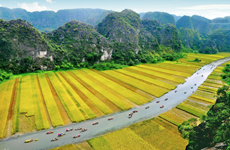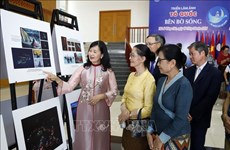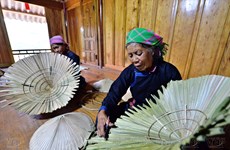Dak Lak works to preserve Ede epics
The Department of Culture, Sports, and Tourism of the Central Highlands
province of Dak Lak has been enacting a series of measures to preserve
and promote volumes of epics of the Ede people, which are currently in
danger of disappearing from the community.
The Department of Culture, Sports, and Tourism of the Central Highlands
province of Dak Lak has been enacting a series of measures to preserve
and promote volumes of epics of the Ede people, which are currently in
danger of disappearing from the community.
Epics have played an important cultural role in the life of the Central Highlands people for centuries.
According to folklorists, the Ede ethnic group boasts nearly 80 epics, the most famous of which include Dam San, Dam Di, Khinh Du, Dam Do Roan, Y Prao, Mhieng, Dam Tiong, and Dam Trao-Ram Rao. The local word for “epic” is “Klei khan”, meaning a storytelling form combining music and lyrics.
The epics describe the socio-economic process that formed and developed the community of ethnic groups, tell tales of the strong and admirable heroes of their mythology, and honour the beauty found in both the physical strength and the will power of the people.
They also praise love between couples and family, encourage the spirit of solidarity among the community, and reflect the desire to conquer nature.
Most Ede epics originate from folklore and are passed down from generation to generation orally or in writing. Some works can be told in one or two nights, but others may last 4 or 5 nights, dictated by the whims of the tellers.
Epic performers are called “po khan”, known for their strong singing voices and their ability to recite a great number of epics by heart. These tellers exude charisma and use their words and actions to transport the audience into the stories, helping them to truly come alive.
The Ede epic performers are highly respected members of the community, believed to be blessed with special abilities and considered “living treasures” of the nation. These talented artists also help create various versions of the Ede epics, enriching the local folklore.
Yet this folklore art genre, a valuable spirit and cultural icon of the Ede people, is slowly eroding within community.
According to Y Ko Nie from the provincial Department of Culture, Sports, and Tourism, the erosion is attributable to strong changes in the socio-economic and cultural habits of the local people and the diminishing options for performance spaces.
As traditional rituals and festivals, where epics are usually performed, are simplified, the number of talented epic artists is quickly decreasing, he noted.
He said his agency is working with institutes for folklore research on collecting, translating and publishing the Central Highlands’ epic treasure.
The region has been organising courses to teach the epics to broader audiences in a bid to conserve the art type, he added.
Under the same vein, the Ministry of Culture, Sports, and Tourism launched a campaign to collect epic songs for digitisation in 2007; thus far 33 Ede epics have been classified. Modern festivals and concerts have also begun incorporating epic performances into their shows.
Recently, the Ministry has officially recognised the epics as a national intangible cultural heritage to Dak Lak and three other Central highlands provinces - Dak Nong, Gia Lai and Kon Tum.
Epics of four ethnic groups in the region received the recognition, including the oral recitation of the Ede in Dak Lak, the Ot Ndrong epic of the M’Nong people in Dak Nong, the Homon epic of Banah in Gia Lai, and the Homon epic of Rongao in Kon Tum.
The epics, believed to have been written in the 16 th century, will be submitted to UNESCO for recognition as a world intangible cultural heritage of humankind.-VNA
Epics have played an important cultural role in the life of the Central Highlands people for centuries.
According to folklorists, the Ede ethnic group boasts nearly 80 epics, the most famous of which include Dam San, Dam Di, Khinh Du, Dam Do Roan, Y Prao, Mhieng, Dam Tiong, and Dam Trao-Ram Rao. The local word for “epic” is “Klei khan”, meaning a storytelling form combining music and lyrics.
The epics describe the socio-economic process that formed and developed the community of ethnic groups, tell tales of the strong and admirable heroes of their mythology, and honour the beauty found in both the physical strength and the will power of the people.
They also praise love between couples and family, encourage the spirit of solidarity among the community, and reflect the desire to conquer nature.
Most Ede epics originate from folklore and are passed down from generation to generation orally or in writing. Some works can be told in one or two nights, but others may last 4 or 5 nights, dictated by the whims of the tellers.
Epic performers are called “po khan”, known for their strong singing voices and their ability to recite a great number of epics by heart. These tellers exude charisma and use their words and actions to transport the audience into the stories, helping them to truly come alive.
The Ede epic performers are highly respected members of the community, believed to be blessed with special abilities and considered “living treasures” of the nation. These talented artists also help create various versions of the Ede epics, enriching the local folklore.
Yet this folklore art genre, a valuable spirit and cultural icon of the Ede people, is slowly eroding within community.
According to Y Ko Nie from the provincial Department of Culture, Sports, and Tourism, the erosion is attributable to strong changes in the socio-economic and cultural habits of the local people and the diminishing options for performance spaces.
As traditional rituals and festivals, where epics are usually performed, are simplified, the number of talented epic artists is quickly decreasing, he noted.
He said his agency is working with institutes for folklore research on collecting, translating and publishing the Central Highlands’ epic treasure.
The region has been organising courses to teach the epics to broader audiences in a bid to conserve the art type, he added.
Under the same vein, the Ministry of Culture, Sports, and Tourism launched a campaign to collect epic songs for digitisation in 2007; thus far 33 Ede epics have been classified. Modern festivals and concerts have also begun incorporating epic performances into their shows.
Recently, the Ministry has officially recognised the epics as a national intangible cultural heritage to Dak Lak and three other Central highlands provinces - Dak Nong, Gia Lai and Kon Tum.
Epics of four ethnic groups in the region received the recognition, including the oral recitation of the Ede in Dak Lak, the Ot Ndrong epic of the M’Nong people in Dak Nong, the Homon epic of Banah in Gia Lai, and the Homon epic of Rongao in Kon Tum.
The epics, believed to have been written in the 16 th century, will be submitted to UNESCO for recognition as a world intangible cultural heritage of humankind.-VNA













